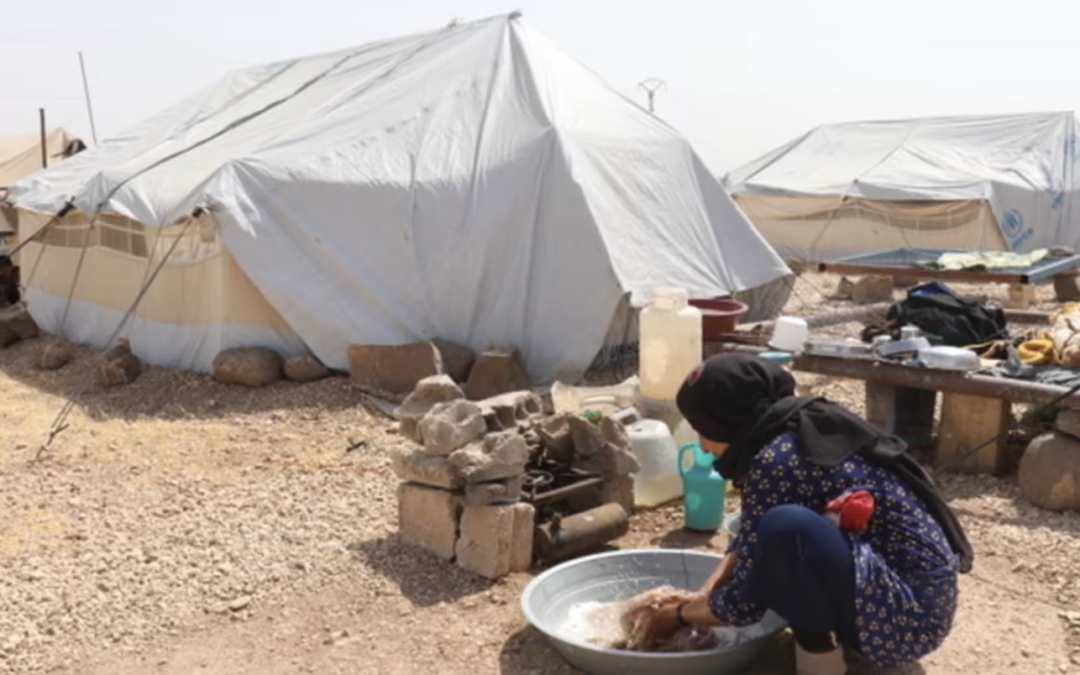Article initially published by Geneva Solutions on October 31, 2023 and written by Annie Sparrow
A crucial monitoring programme tracking the forced displacement of millions of Syrians was quietly cut by the International Organization for Migration. One of the first priorities of the UN agency’s new boss should be to reinstate it, writes war zone clinician Annie Sparrow.
Since 1 October, when Amy Pope assumed leadership of the International Organization for Migration (IOM), this increasingly important United Nations agency is back under the direction of a US citizen. Pope unseated incumbent Antonio Vitorino, who had allowed IOM to help the Syrian government cover up its repression, the major factor driving displacement and prohibiting safe returns.
When it comes to forced displacement, the Syrian government leads the world. For much of the past decade, the Syrian government has bombed, besieged, gassed, starved, tortured, executed, detained and disappeared civilians in opposition-held areas or who were deemed to be hostile to the Assad regime. That brutality has driven more than 14 million Syrians from their homes, half refugees and half internally displaced – two-thirds of Syria’s pre-war population.
Vitorino’s predecessor, veteran US diplomat William Lacy Swing, had been increasingly at odds with the Syrian government because of IOM’s accurate reporting on the number of displaced, which ultimately resulted in IOM’s expulsion from Damascus in January 2018.
IOM had opened its Damascus office in 2001 and cultivated a close relationship with Asma Assad, the wife of Syrian President Bashar al-Assad. When the government’s violent suppression of anti-government protests escalated into armed conflict in 2012, the UN-led response coordinated by its Office for Humanitarian Affairs (OCHA) arrived. Any data about conditions in the country that came to Damascus-based international agencies was denied, delayed, or diluted by the government.
By contrast, independent Syrian-led efforts coordinated from Turkey provided accurate, timely and essential information – as exemplified by their confirmation of the 2013 polio outbreak, which the government covered up for months. Like UN agencies operating from Damascus, IOM faced government restrictions that limited its access to areas outside of government control.
Yet by 2015, most of Syria was outside of government control. Although the UN Security Council had authorised cross-border humanitarian aid, any movement by Damascus offices to provide that aid would inflame Assad. Instead of fulfilling its core responsibilities to track forced movement of millions and to monitor conditions required for their safe return, IOM was reduced to regurgitating regime propaganda. Frustrated, Lacy Swing found another way.
IOM Turkey partnered with an independent Syrian NGO with a large network across Syria. Scores of enumerators collected detailed information from thousands of key informants covering 70 per cent of the country, including some parts under government control. Because IOM equipped enumerators with digital tools to transmit information directly, data was not subjected to government manipulation.
To reduce the risk to IOM’s Damascus office, this displacement tracking matrix was called the Needs and Population Monitoring Program (NPM), and reports were published by Ocha. The NPM informed the 2015 humanitarian needs overview, which highlighted the Syrian government’s mass atrocities and showed that 11 million people in need of aid in areas outside of government control were fully accessible from Turkey.
This move annoyed the Syrian government. It worried that IOM’s revelation would strengthen cross-border programming and compromise its ability to siphon off aid channelled through Damascus. Its edited 2016 Humanitarian Response Plan contains no population total or disaggregation of data for government and non-government territory and uses euphemisms for conflict and displacement.
In 2016, the NPM expanded to include assessments of land and housing, further angering the Syrian government because property issues affected the stability of communities and the possibility for voluntary returns. Nor was Damascus happy that IOM included these issues in its January 2017 humanitarian funding appeal.
In October 2017, a UN human rights analysis referencing IOM and NPM reports concluded that conditions were unconducive to return. This contradicted the Syrian government’s whitewashing and its quest for Western reconstruction aid. After deputy foreign minister Feisal Mekdhad complained to the Security Council, Lacy Swing shut down the NPM.
Nonetheless, the Syrian government expelled IOM. Because the Damascus office IOM managed far fewer funds than larger UN agencies such as the World Food Programme, the Syrian government risked little, but it sent a message to other UN agencies not to cross the government’s red lines.
In humanitarian terms, IOM’s expulsion from Damascus made little difference. On the rare occasions when Mekdhad approved IOM’s requests for humanitarian convoys, the Ministry of Health refused permission to include critical medicines and essential surgical items.
However, Assad’s calculus ignored that expelling IOM from Damascus enabled it to resume the Turkey-based NPM. In April 2018, it was reactivated under a new name, the Humanitarian Needs Assessment Program, or HNAP. Assad’s scorched-earth policies displacing more than three million more people across 2018-2019 underscored the need for HNAP.
Although fighting has diminished since early 2020, repression has not. According to HNAP numbers, the number of internally displaced people grew to 6.9 million. During the first quarter of 2022, voluntary returns of refugees were a mere 1,256, a ten-fold decrease compared with the same period in 2020. That dramatic reduction was the result of illegal property seizure by Hezbollah, arbitrary arrests, forced recruitment, and other forms of government retaliation. Since enumerators remained in-situ throughout, they retained the trust of communities no matter which armed force controlled the ground.
The Syrian Government was desperate to suppress IOM’s reports documenting the ongoing persecution of Sunni Muslims in case these jeopardized Assad’s rapprochement with Saudi Arabia. Since Vitorino was desperate to return IOM to Damascus, he agreed, according to verified sources, to shut down the HNAP as a precondition for IOM’s return.
By November 2022, data collection had stopped. Preoccupied by the impending renewal-or-not of cross-border aid on 9 January, few noticed the disappearance of HNAP reports until 12 January, Then, HNAP’s new manager pretended it was only a temporary suspension, and Vitorino blamed a lack of funds. Yet IOM’s 2023 proposals to its main funders, the United States and the European Union, did not include HNAP. At $4 million per year, HNAP is small humanitarian change. Moreover, since the UN Humanitarian Response Plan for Syria -– assessed at $5.4 billion for 2023 – depends on data to inform programming, the payoff is massive.
Within weeks, the devastation caused by the 6 February 2023 earthquake clarified the importance of the missing HNAP data. UN agencies trying to respond to the massive needs were operating blind. But Vittorino rebuffed pleas to reactivate HNAP, and under UN secretary general Antonio Guterres’s leadership, UN agencies stopped complaining. IOM provided a cautionary tale. No one wants to get kicked out of Damascus because presence is key to receiving the massive aid funds that flow to Syria. Conveniently, the lack of data also removes the ability to report on efficacy.
At the Future of Syria conference in Brussels in June, donor governments pledged $6bn in grants for 2024 and beyond. But without reliable data or reporting channels, donors are at the whim of the Syrian government to determine where aid is delivered. Despite Vittorino’s capitulation on HNAP, IOM’s office in Damascus has not yet been allowed to reopen.
In fact, since Amy Pope has taken over, she seems to have abandoned Vitorino’s misguided efforts to return to Damascus, apparently in line with the US government’s stance against normalisation of relations with Assad. However, to end IOM’s complicity in the Syrian government’s efforts to divert aid and undermine accountability for that assistance, Pope must take positive action. Rather than continue Vitorino’s unseemly deference to Damascus, Pope should embrace IOM’s expulsion from Damascus – a distinction that continues Lacy Swing’s legacy.
Pope’s first step should be to reinstate that monitoring programme. Even though Washington has cut overall humanitarian funding to Syria, it remains the largest donor to UN humanitarian operations, including the IOM, and has the clout to insist that the IOM resume its core function of tracking forced displacement and voluntary return. The UN as a whole should stand behind the importance of HNAP as a requirement for a needs-based approach to humanitarian aid. This action is a prerequisite to effective humanitarian and, ultimately, reconstruction and development assistance to Syria.
Annie Sparrow, MBBS, MD MPH, is a war zone clinician and associate professor at the Icahn School of Medicine at Mount Sinai. She has worked extensively on Syrian medical and humanitarian issues.
Geneva Solutions publishes opinions and columns proposed by or requested from external contributors and experts. These texts reflect the point of view of their authors and do not represent the position of the media.
Read the full article on genevasolutions.news


Recent Comments